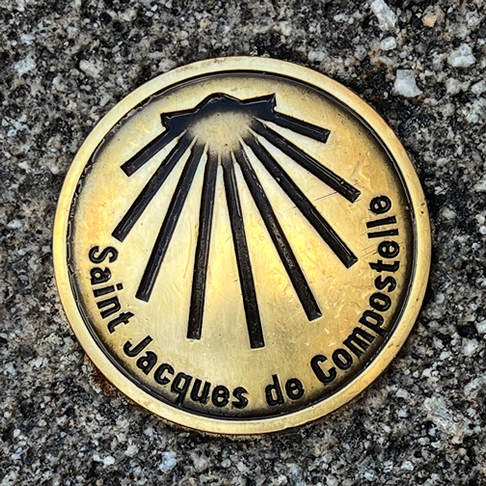
Too many photos! Too many stories! So I’ve divided our adventure into two blog posts. Part One is the background of our journey on the Chemin de Compostelle and the big kick-off in the historic and beautiful city of Le-Puy-en-Velay. Part Two covers our eight days of walking, through lovely, ever-changing country … with a lot of cows … and flies.
How did I get here?
As often happens, I was chatting with my friends Maryse and Claude about interesting places to visit in France. Somehow, we landed on the Chemin de Compostelle (Camino de Santiago, or The Way), and in particular, the portion that starts in Le-Puy-en-Velay and ends in Conques, a walk of about 220 kilometers. They agreed that this is widely considered to be the prettiest section of the Chemin in France.
Claude gave me a wistful look and said that he’d wanted to do this for 40 years. So I said, “Let’s do it!”
He looked sad and said, “Heh, I’m old and not in good enough shape to do that much walking.”
“OK, let’s take a car, and drive a little and walk a little.”
He was horrified. “You can’t take a car on the Chemin. It must be walked.”
“OK, then let’s figure out a way to walk it.”
And so we did.
That conversation was a few years ago, and there was Covid, so it took a while. I wasn’t completely certain that it would happen. And then suddenly, it was happening. On the morning of June 8, we aimed the car toward Le-Puy-en-Velay, one of the traditional starting points for the Chemin de Compostelle.
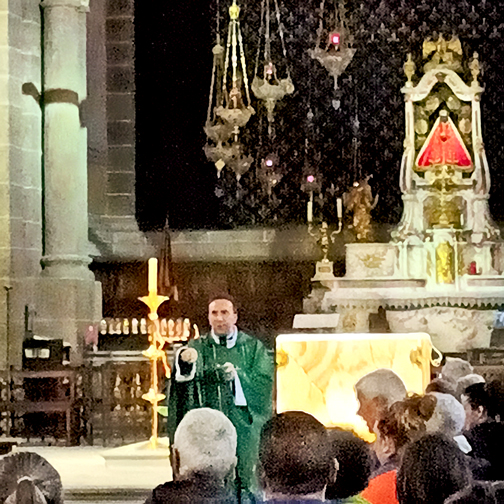
A good start
I had done a small amount of reading about walking the Chemin. I know a few people who have done parts of it, all of them starting in the far southwest corner of France and walking into Spain, or starting in San Sebastián and walking only in Spain. I didn’t know anyone who had walked any of the French routes, all of which come together in Saint-Jean-Pied-de-Port to cross the Pyrenees and enter Spain.
There was one event I’d read about that sounded intriguing, and I wanted to participate. I mentioned it to Claude in the car that first day.
“There’s a 7:00 mass every morning, followed by a benediction for the pilgrims who will depart that day. I’d like to go.”
He promptly demurred, as I thought he might. I told him that I was fine to go alone, and I could meet him afterward to start our journey. But I was going.
I figured that as long as I was here to walk this ancient pilgrim route, I might as well experience the whole of it. That morning, I arrived ten minutes early. Inside, there was already a sizeable group; the cathedral was brightly lit and felt pretty darn welcoming for a huge 1,000-year-old stone building. Perhaps this is a good time to note that I’m neither a Christian nor religious, but spirituality is important to me. And it’s deeply personal.
The mass began, and the theme was adultery, and of course it was all in French, so I could barely keep up. I got the general idea. I gazed at the medieval carvings and at the art and sculptures that had been added over the centuries. I was fascinated by the excellent condition of the stones; the building looked brand-new. This cathedral is famous for its black Madonna, who has pride of place at the altar. I counted around 140 people in the pews.
When the mass was over, half the people got up to leave, but a few more had arrived. The night before, Claude had decided to come for the benediction, so I kept looking around for him, but I didn’t see him.
The priest began the benediction with some humor, which I didn’t understand, but the crowd chuckled. Then he asked how many of the 75 or so of us were from outside of France. A few hands went up, and the priest began pointing.
“Austria.” (3 people)
“Germany.” (2 or 3 people)
“The United States,” I said. (3 of us)
There were two more, from South Africa, but I wasn’t giving it my full attention because I was still looking for Claude and also trying to figure out who were the other two Americans. But that was it. Everyone else was French.
So the priest began asking about regions of France, narrowing it down to départements and then to cities and villages. It took him about ten minutes to do something utterly magical: he created a community out of this group of random strangers who happened to have shown up in the cathedral that morning. There was a palpable sense of connection between us as we looked around and made eye contact with each other.
The priest then got into the business of the benediction. He suggested that we might have intentions for this journey, things to pray about. He gave us a moment of quiet to think about it. I had pondered this in the weeks before leaving, so I was ready. The priest then invited us, after the benediction was over, to come to the front and take a piece of the paper that they were offering, write down our intention or prayer, and then slip the paper into the slot of one of their wooden boxes.
But before we did that, there was communion for those who chose it, and the benediction was completed, and then something glorious happened. Like in many cathedrals, there is a decorative metal grate in the floor of the main aisle. This often gives a view of the crypt below, but that’s not the case here. As the priest was speaking, a vertical grate of the same design began to rise from the floor, creating a low fence that fully blocked the aisle. Then the floor grate divided in two and began to fold open, revealing a stone stairway.
“I invite you, all of you pilgrims who are leaving today to walk toward Compostelle, to begin your journey by descending these stairs, which have been used by departing pilgrims for a thousand years.”
Well, wow.
I’d been sitting near the grate, and I hovered around for a few moments, soaking up the sheer majesty of the moment, and gazing at those stairs, and feeling unexpectedly moved by the whole experience. Then I walked to the front, found a nice lady offering paper and pens, and stepped aside to write down my intentions for my journey. I placed my paper in a box, and then I took the priest’s second suggestion: I selected a page that had been written by another pilgrim who had departed within the past few days. Throughout the next two weeks, I not only pondered my own intentions, I pondered hers, carrying her paper next to my heart for the full journey.


Le-Puy-en-Velay
The history
Le-Puy-en-Velay is famous for three things: its delicious green lentils, its lovely hand-made lace, and for being the starting point of the Via Podiensis, one of the primary pilgrimage routes to Santiago de Compostela in Spain, 1,522 kilometers away (946 miles).
James, cousin of Jesus, went to Spain to evangelize, apparently without much success. When he returned to the Holy Land, he was killed by Herod in 44 AD. His followers took his body to the coast, where a boat miraculously appeared. This boat—made of stone!—carried the group to the northwestern shore of Spain, and the remains of James and two of his disciples were buried on a hillside. James was forgotten.
Early in the 9th century, a hermit named Pelagius had a vision of a bright star surrounded by smaller stars, and he reported this to the local bishop. When the vision was investigated, a tomb was found on a hillside, and it was determined that these were the remains of James and his followers. The king declared Saint James—Santiago—to be the patron saint of Spain, and a church and monastery were built. A town grew around this church, a town named Compostela.
About a hundred years later, in 951, Bishop Godescalc of Le-Puy-en-Velay returned from a pilgrimage to Compostela, believed to be the first such pilgrimage to Compostela by someone from outside of Spain. To celebrate this event, Godescalc had a chapel built atop a needle of volcanic stone, in the valley of Le-Puy-en-Velay, in a spot where an ancient dolmen already sat. The dolmen was probably from around 3,000 BC; later the Romans rededicated it to Mercury. When the chapel was built, several stones from the dolmen were incorporated into the structure. The chapel was dedicated to the Archangel Michael (patron saint of high places), hence its name, Saint-Michel d’Aiguilhe (aiguille is French for needle).
Before pilgrims started arriving to begin their journey to Compostela, though, they came to Le-Puy-en-Velay as a destination in itself. The region is scattered with ancient dolmen sites, Roman temples, hermit caves and tiny medieval chapels. There are stones with reputed curative powers that predate Christianity; one enjoys a place of honor in the cathedral. A steady stream of royalty visited this sacred place, including Charlemagne (772 and 800); Charles the Bald (877); and Philip Augustus (1183). The Black Madonna in the cathedral is a reproduction of the original, given by Louis IX in 1254 when he returned from his pilgrimage to the Holy Land (this is the chap who later became Saint-Louis). Joan of Arc’s mother, Isabelle Romée, visited in 1492.
People have been living here for a very long time, and this is one of those places where it feels like all those other civilizations are crowded amongst us, right at the surface, bubbling like the molten lava that made this place. The very earliest humans, perhaps 40,000 years ago; the Bronze Age people who built thousands of dolmens all over France; the Romans, the Franks, the Celts, the Visigoths. The French who won Britain and then turned around and fought the French. So much of French history is roiling just beneath the surface here, and if you look closely, you’ll be able to see, too.

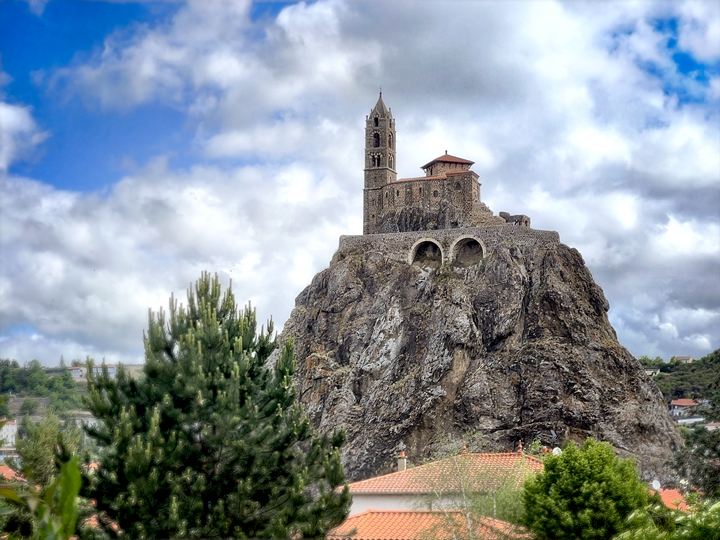
The sights
We had given ourselves a full day to explore Le Puy, and it wasn’t even close to enough time!
Our day began in a somewhat unexpected way when our walk into the heart of the town took us past an enticing park, which turns out to be an exquisite jewel of a park that hosts a variety of the world’s trees. There’s a Giant Sequoia here, and a Douglas Fir. There’s a sweet little lake, with a swan and a young family of ducks. There are peacocks and other birds. But the trees! They are majestic and splendid. If you find yourself in Le-Puy-en-Velay, the Jardin Henri Vinay is a fine place for a breath of fresh air.
We left the greenery behind and walked into the old heart of the city, a city that dates back to at least 800 AD, if not earlier. We were headed first to Saint-Michel d’Aiguilhe. Along the way, we passed an exquisite little 12th-century chapel, in the same multicolored style as all the other medieval religious structures. It’s Chapelle Saint-Clair, and the lintel over the door depicts the phases of the moon. I like that.
We arrived at Saint-Michel d’Aiguilhe, quickly toured the museum, and then climbed 268 steps to the top. Along the way, we passed the ruins of an ancient hermit’s cave, and we caught our breath by pretending to take photos of the city sprawled at our feet. This is what we saw when we arrived at the top:
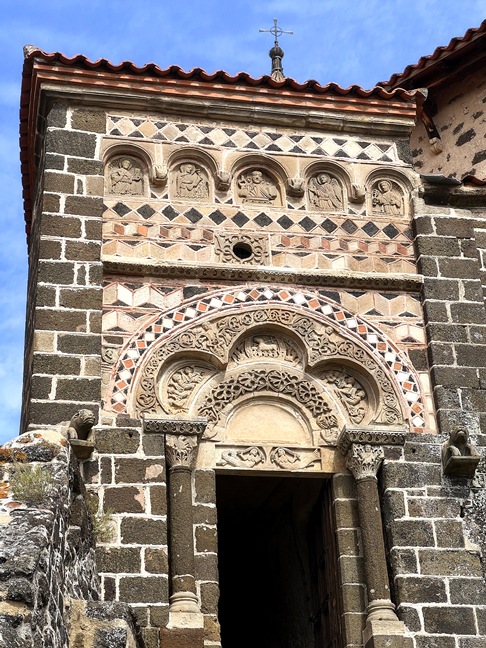
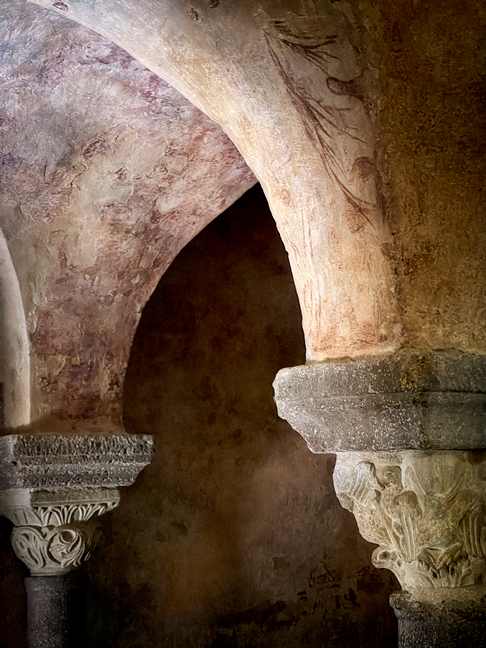

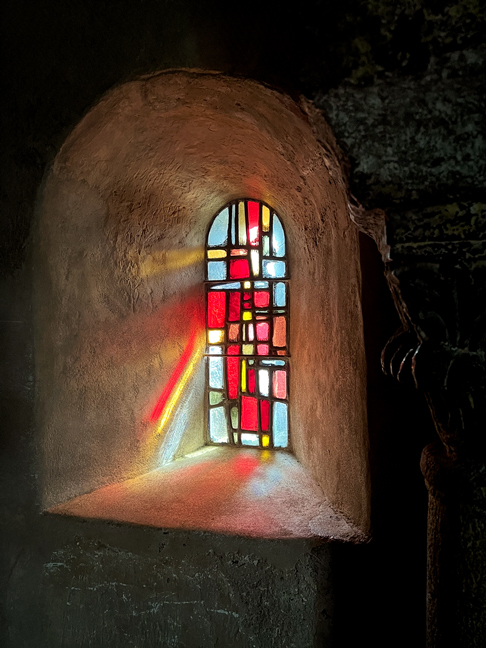
We descended the volcanic needle and walked uphill toward the cathedral, a sprawling complex that seems to have no obvious point of entry. We were headed to the cloister. In my experience, a cloister is often a lovely surprise, often a disappointment, but it’s always worth finding out. This was, hands down, the most elaborate, detailed, exquisite cloister I have ever seen. We were both instantly captivated, and we spent more time here than we’d planned.
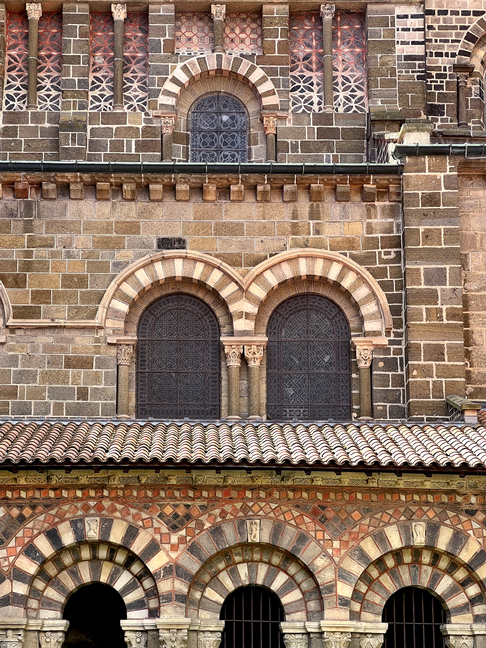

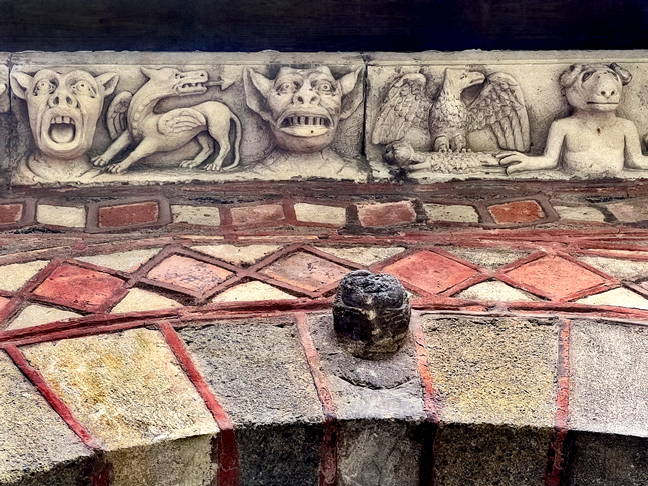
We took a break for lunch at a nearby restaurant, and then returned to see the cathedral itself. It’s a stunning example of medieval architecture and construction, situated as it is on a steep hill. There was a dolmen on the site, probably dating to around 3,000 BC; in the 2nd century a Roman temple was built, which was then converted to a church in the 6th century. Remains of the Roman structure and this first church can be still be seen.
To accommodate the growing number of pilgrims coming to Le Puy, a much larger cathedral was built in the 11th century. Within a hundred years, it was deemed too small and an ambitious extension was built.
Picture a medieval stone cathedral, already large and perched atop a steep hill; then imagine that the decision was made to enlarge it further by extending the structure horizontally, over air. To accomplish this, massive stone pillars were built in the existing porch and extending partway down the hill, and then the cathedral itself was built atop those pillars. When you’re standing there, both inside and outside, you can’t tell that’s how it happened; it just looks like a medieval cathedral built on a hillside. The engineering is breathtaking, and by the way, the structure has never failed in 900 years.

Inside, we gazed at the improbably new-looking stone structure, the stained glass, the art of a thousand years. We saw the dolmen stone where Mary cured a woman who had a fever; it’s now called the Fever Stone. We stopped and gazed at a remarkable 13th-century fresco of the martyrdom of Saint Catherine of Alexandria.
We visited the shop and purchased postcards, shells for our backpacks, and the pilgrim’s passport (credential in French) where we’d receive a stamp at each stop along the Chemin.
I’d noticed a mention of 11th-century frescoes that had recently been uncovered and restored, but I couldn’t figure out where they were. After searching with no success, I returned to the shop to ask if it was possible for us to see the frescoes. The fellow immediately reached into a drawer and extracted an old skeleton key. Taking a piece of my i.d. in exchange for the key, he told me where to find a small doorway tucked into a corner. I found Claude, and off we went, opening the tiny wooden door and climbing well-worn stone steps to the upper level of the cathedral. We creaked open a second door, and gasped.
We were standing in a sort of porch in the upper transept. All three walls were alive with colorful frescoes; it appeared that every square inch would have been painted (not all survived). Of course, all of them were biblical characters, each depicted with his or her own unique symbols, and Claude pointed out that in this way, the Bible could come to life for people who could not read. By far the most impressive was an immense Archangel Michael, 18 feet tall. It was a magnificent place to stand and gaze: the vibrant colors, the rich textures, the remarkably clear drawings, and the sheer number of figures. Big thanks to the dude in the gift shop!
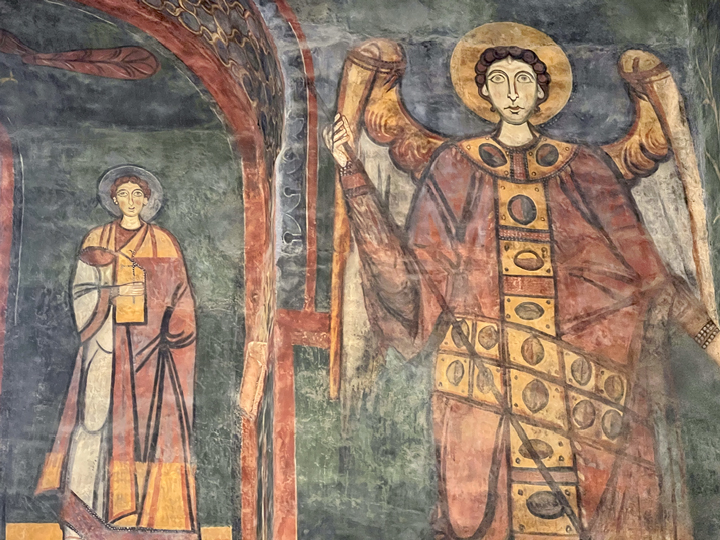

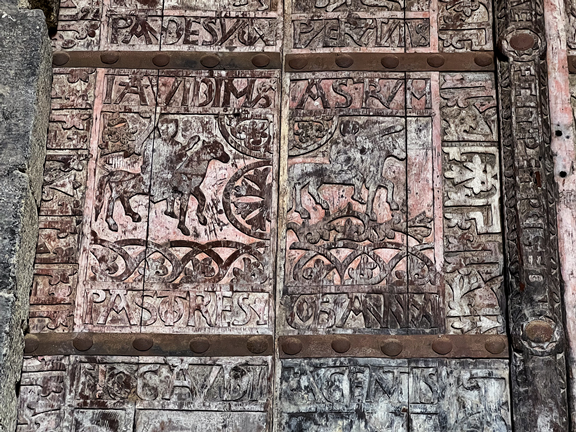
When we left, we circled back to the lower levels of the original church, where we saw two incredible doors. After examining them for a while, we ducked inside another door, the exit for the cloister, and asked if the man could tell us anything about these doors. He jumped up with great enthusiasm and came outside to talk with us. He told us that the doors are original to the 11th-century cathedral and that they’re made of pine. (In researching information for this story, I found several references online to the doors being made of cedar.) No matter which wood, they’re 1,000-year-old wooden doors, facing outdoors, that still have traces of their original paint. The writing is in both Latin and Arabic, and like with the architecture of the building, there are elements of Islamic design here.
Back at his station inside, he confirmed that the fresco I’d photographed earlier in the day is indeed from the 2nd century. It’s the photo below, of two of the Apostles. It was such a pleasure talking with this young man, who clearly loves to share his cathedral with admiring visitors.

Other aspects of Le-Puy-en-Velay
At both the beginning and the end of our two-week journey, we took a little time to explore the tiny streets and shops of the old center of Le Puy.
At one point, we walked along a busy street that was divided by an island in the middle, which held a bronze statue of a man. I thought the profile looked much like the statues I’ve seen in Washington DC of the Marquis de Lafayette, but I didn’t really think much beyond that. And then later, looking at the map of Le Puy, I saw that this was indeed a statue of Lafayette, who was born near Le-Puy-en-Velay.
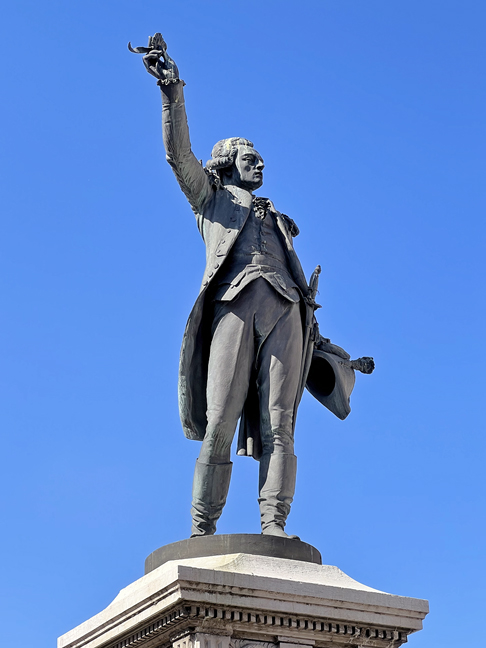




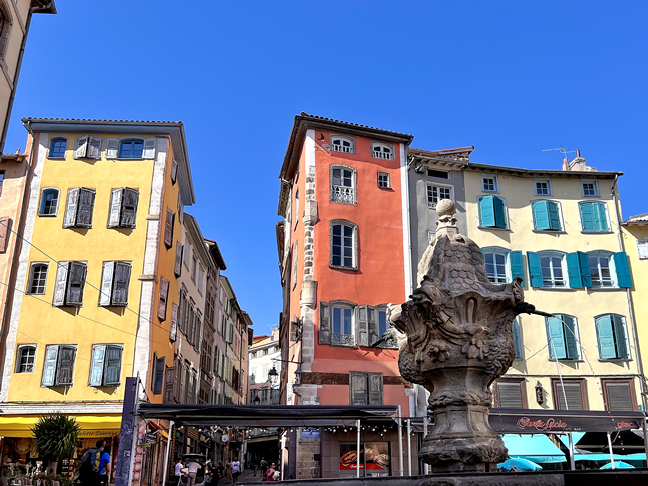
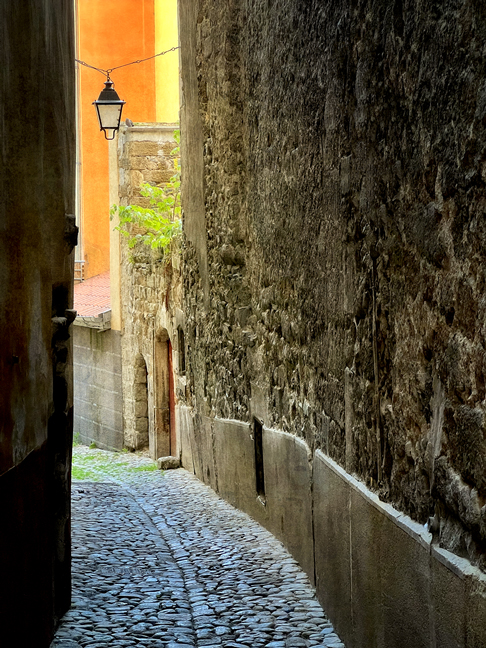
I quite liked the small city of Le-Puy-en-Velay. It’s bigger than I expected, and while it certainly puts a lot of focus on pilgrims walking the Chemin, it also has its own lively history and dynamic culture. There is a great deal to see and do here, and it was a dandy place to start our journey.
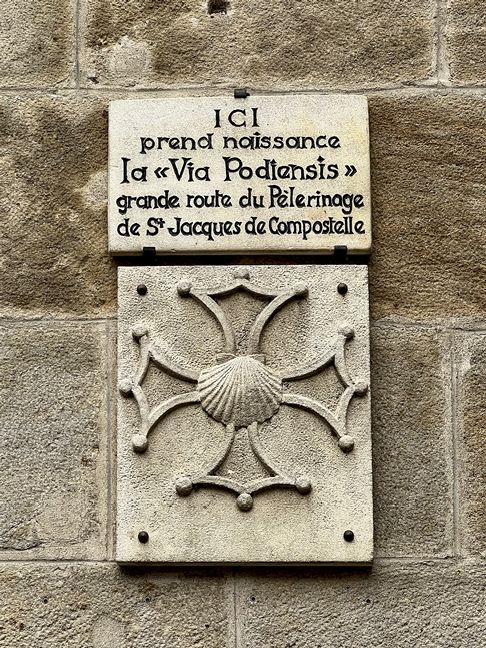

Great post – and photos!
I especially like the stonework photos. So many varieties, colors…lovely.
LikeLike
Merci, Trish! Yes, that colorful stonework was endlessly fascinating. Thanks for writing!
LikeLike
Exquisite in every way Lynne—the details, the photographs, and the feelings shared. Thank you! I so enjoy your blogs and often share them with Santa Fe and TX friends. This is a one I must share. Hugs from Greensboro where Philip Cook and I are enjoying a month in the Northeast Kingdom of VT.
LikeLike
Bonjour, Liz! How great to hear from you, and thank you for your kind words. High praise, and I’m honored. I’m also happy to hear that you’ve escaped to what I hope is a cooler place to be for part of the summer!
LikeLike
I’ve read several books about walking The Way. How nice to see pictures & to learn about your experiences.
LikeLike
Hi Cathy, thank you for writing today. I’m glad you enjoyed the post! Do check in again in 2-3 weeks, because I’ll have the follow-up post to this one, which will have lots of photos from 8 days of walking on the Chemin.
LikeLike
Hi!
So wonderful to see these marvelous photos & hear your impressions of the town. I’ve been meaning to write you for you so long now. And I’m glad to see that you are doing very well in France at the moment. That’s great.
I can’t wait to read Part 2 from where I am in Germany.
Best wishes & take care.
LikeLike
Bonjour and thank you for writing, thank you for your nice compliment. I’m glad you enjoyed the post!
LikeLike
Really enjoyed this. I actually live on the Compostella route in Central France. We’re just starting to see pilgrims again, heading through our village to St Leonard De Noblat, and further to Limoges. I’d like to do it one day, starting from home.
LikeLike
Hello, and thank you for writing! I encourage you to experience the Chemin. It is like nothing else.
-Lynne
LikeLiked by 1 person